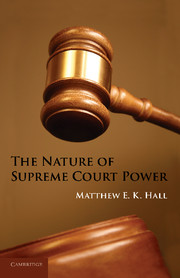Book contents
- Frontmatter
- Contents
- List of Figures
- List of Tables
- Preface
- 1 Neither Force, Nor Will
- 2 When Courts Command
- 3 Judging the Court
- 4 Popular Vertical Issues
- 5 Unpopular Vertical Issues
- 6 Popular Lateral Issues
- 7 Unpopular Lateral Issues
- 8 Neither the Sword nor the Purse, but the Keys
- Appendix I Case Selection
- Appendix II Survey Information and Citations
- Appendix III Supporting Data for Figures
- Appendix IV Statistical Analysis on the Effects of the Pico Ruling
- Appendix V Behavior Conformity Calculations
- Appendix VI Statistical Analysis of Behavior Conformity
- Appendix VII The Effects of Unanimity on Behavior Conformity
- Case References
- References
- Index
5 - Unpopular Vertical Issues
Published online by Cambridge University Press: 06 December 2010
- Frontmatter
- Contents
- List of Figures
- List of Tables
- Preface
- 1 Neither Force, Nor Will
- 2 When Courts Command
- 3 Judging the Court
- 4 Popular Vertical Issues
- 5 Unpopular Vertical Issues
- 6 Popular Lateral Issues
- 7 Unpopular Lateral Issues
- 8 Neither the Sword nor the Purse, but the Keys
- Appendix I Case Selection
- Appendix II Survey Information and Citations
- Appendix III Supporting Data for Figures
- Appendix IV Statistical Analysis on the Effects of the Pico Ruling
- Appendix V Behavior Conformity Calculations
- Appendix VI Statistical Analysis of Behavior Conformity
- Appendix VII The Effects of Unanimity on Behavior Conformity
- Case References
- References
- Index
Summary
The very purpose of a Bill of Rights was to withdraw certain subjects from the vicissitudes of political controversy, to place them beyond the reach of majorities and officials and to establish them as legal principles to be applied by the courts. One's right to life, liberty, and property, to free speech, a free press, freedom of worship and assembly, and other fundamental rights may not be submitted to vote; they depend on the outcome of no elections.
Justice Robert H. JacksonIn this chapter, I examine unpopular vertical issues – cases in which the Supreme Court issued an unpopular ruling that could be implemented by lower-court judges. Each of these rulings faced significant public opposition, and some of them were overwhelmingly disfavored in public opinion polls. Consistent with my theory of judicial power, I find that the Supreme Court successfully exercised power in each of these cases. Accordingly, these cases highlight Bickel's “countermajoritarian difficulty” by demonstrating the Court's ability to flout public opinion and impose its will on public policy when issuing rulings in vertical issues.
ABORTION
On January 22, 1973, the Supreme Court issued its opinion in Roe v. Wade. The case involved a single pregnant woman from Texas, Norma Leah McCorvey (dubbed “Jane Roe” to protect her identity), who sought to terminate her pregnancy in violation of a Texas criminal abortion law. The Texas law was similar to laws in most states that prohibited abortion unless the pregnancy seriously threatened the life of the mother.
- Type
- Chapter
- Information
- The Nature of Supreme Court Power , pp. 38 - 96Publisher: Cambridge University PressPrint publication year: 2010
- 1
- Cited by



